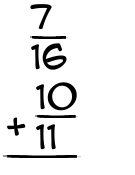What is 7/16 + 10/11?

|
This is how you add
|
|||||||||||
Step 1We can't add two fractions with different denominators (the bottom number). So you need to get a common denominator - both bottom numbers need to match. To do this, you'll multiply the denominators times each other... but the numerators have to change, too. They get multiplied by the other term's denominator. So we multiply 7 by 11, and get 77, then we multiply 16 by 11 and get 176. Do the same for the second term. We multiply 10 by 16, and get 160, then multiply 16 by 11 and get 176. So now our fractions look like this:
|
|||||||||||
Step 2Since our denominators match, we can add the numerators. 77 + 160 = 237 Now we have an answer.
|
|||||||||||
Step 3Last of all, we need to simplify the fraction, if possible. Can it be reduced to a simpler fraction? To find out, we try dividing it by 2... No good. So next you try the next prime number, which is 3... No good. So next you try the next prime number, which is 5... No good. So next you try the next prime number, which is 7... No good. So next you try the next prime number, which is 11... No good. So next you try the next prime number, which is 13... No good. So next you try the next prime number, which is 17... No good. So next you try the next prime number, which is 19... No good. So next you try the next prime number, which is 23... No good. So next you try the next prime number, which is 29... No good. So next you try the next prime number, which is 31... No good. So next you try the next prime number, which is 37... No good. So next you try the next prime number, which is 41... No good. So next you try the next prime number, which is 43... No good. So next you try the next prime number, which is 47... No good. So next you try the next prime number, which is 53... No good. So next you try the next prime number, which is 59... No good. So next you try the next prime number, which is 61... No good. So next you try the next prime number, which is 67... No good. So next you try the next prime number, which is 71... No good. So next you try the next prime number, which is 73... No good. So next you try the next prime number, which is 79... No good. So next you try the next prime number, which is 83... No good. So next you try the next prime number, which is 89... No good. So next you try the next prime number, which is 97... No good. So next you try the next prime number, which is 101... No good. So next you try the next prime number, which is 103... No good. So next you try the next prime number, which is 107... No good. So next you try the next prime number, which is 109... No good. So next you try the next prime number, which is 113... No good. So next you try the next prime number, which is 127... No good. So next you try the next prime number, which is 131... No good. So next you try the next prime number, which is 137... No good. So next you try the next prime number, which is 139... No good. So next you try the next prime number, which is 149... No good. So next you try the next prime number, which is 151... No good. So next you try the next prime number, which is 157... No good. So next you try the next prime number, which is 163... No good. So next you try the next prime number, which is 167... No good. So next you try the next prime number, which is 173... No good. So next you try the next prime number, which is 179... No good. 179 is larger than 176. So we're done reducing. And we're done! Here's the final answer to 7/16 + 10/11
|